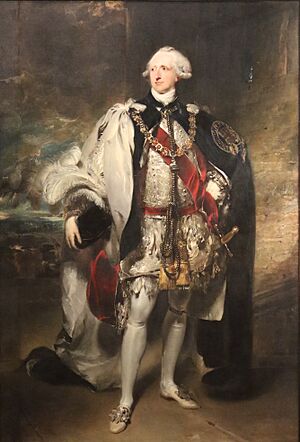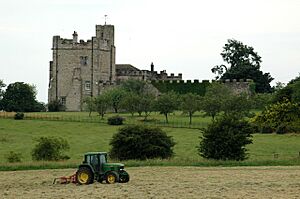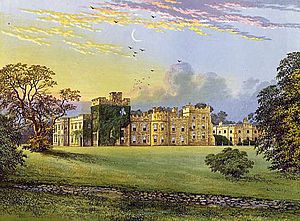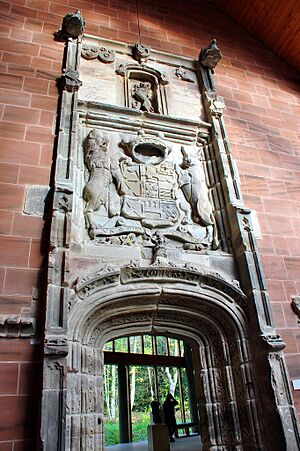Hornby Castle, North Yorkshire facts for kids
Hornby Castle is a very old and strong house. It is located in North Yorkshire, England. This special building sits between the towns of Bedale and Leyburn. It is a Grade I listed building, meaning it is very important historically.
The castle started as a 14th-century building. Over the years, it was changed and updated many times. These changes happened in the 15th, 18th, and 20th centuries. It is built from strong sandstone rocks. Its roofs are made of lead and stone. Today, the castle is the southern part of a much larger complex. The rest of the old buildings were taken down.
Contents
Hornby Castle: A Historic Home
Early Days and Changing Hands
Hornby Castle has a long and interesting past. At the end of the 14th century, the St Quintin family owned it. Later, a young woman named Margaret Quintin married John Conyers. This marriage brought the castle into the Conyers family.
In the 15th century, William Conyers, 1st Baron Conyers rebuilt much of the castle. He kept an older tower from the 14th century. This tower was named after the St. Quintins. However, this old tower was later taken down in 1927.
When John Conyers, 3rd Baron Conyers passed away in 1557, his daughter Elizabeth inherited the estate. She was married to Thomas Darcy. The castle then stayed with the Darcy family for many years. They became known as the Earls of Holderness in 1682.
Rebuilding and New Designs
During a time of conflict in England, known as the English Civil War, Hornby Castle was captured. Colonel Ralph Assheton took control of it. He was a leader for the Parliament's forces. Even though there was an order to damage the castle, it was not carried out.
In the 1760s, a famous architect named John Carr from York made big changes. He rebuilt much of the house for the 4th Earl of Holderness. The part of the castle you see today, the south range, was his work. He also built an east range and other buildings. The east range was later taken down in the 1930s.
The Dukes of Leeds and Modern Times
The 4th Earl of Holderness had a daughter named Amelia. She married Francis Osborne. He later became the 5th Duke of Leeds. Amelia inherited the castle. She brought many beautiful old pieces of furniture to Hornby.

When Amelia passed away in 1784, her son George Osborne, 6th Duke of Leeds inherited the estate. After another family home was removed in 1811, Hornby Castle became the main home for the Dukes of Leeds. It remained their main home until George Osborne, 9th Duke of Leeds.
In 1930, the large estate was divided and sold. Much of the castle was taken down at that time. A beautiful 16th-century main doorway from the castle is now kept safe. You can see it in the Burrell Collection museum in Glasgow.
The part of the castle that remains today was bought in 1936. Major-General Walter E. Clutterbuck purchased it. It has since passed down through his family. The castle is a private home. It also has a deer park and a working farm. Because it is a private residence, you cannot visit the inside. However, the gardens are sometimes open to the public during certain times of the year.
See also
- Grade I listed buildings in North Yorkshire (district)
- Listed buildings in Hornby, Richmondshire
- Hornby Castle, Lancashire




